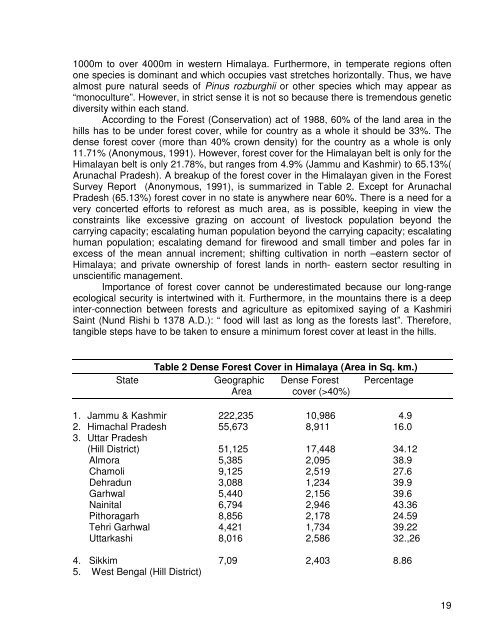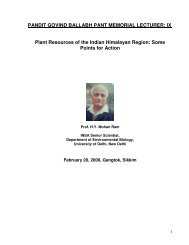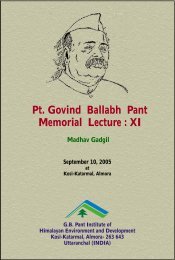Pandit Govind Ballabh Pant Memorial Lecture: II
Pandit Govind Ballabh Pant Memorial Lecture: II
Pandit Govind Ballabh Pant Memorial Lecture: II
You also want an ePaper? Increase the reach of your titles
YUMPU automatically turns print PDFs into web optimized ePapers that Google loves.
1000m to over 4000m in western Himalaya. Furthermore, in temperate regions often<br />
one species is dominant and which occupies vast stretches horizontally. Thus, we have<br />
almost pure natural seeds of Pinus rozburghii or other species which may appear as<br />
“monoculture”. However, in strict sense it is not so because there is tremendous genetic<br />
diversity within each stand.<br />
According to the Forest (Conservation) act of 1988, 60% of the land area in the<br />
hills has to be under forest cover, while for country as a whole it should be 33%. The<br />
dense forest cover (more than 40% crown density) for the country as a whole is only<br />
11.71% (Anonymous, 1991). However, forest cover for the Himalayan belt is only for the<br />
Himalayan belt is only 21.78%, but ranges from 4.9% (Jammu and Kashmir) to 65.13%(<br />
Arunachal Pradesh). A breakup of the forest cover in the Himalayan given in the Forest<br />
Survey Report (Anonymous, 1991), is summarized in Table 2. Except for Arunachal<br />
Pradesh (65.13%) forest cover in no state is anywhere near 60%. There is a need for a<br />
very concerted efforts to reforest as much area, as is possible, keeping in view the<br />
constraints like excessive grazing on account of livestock population beyond the<br />
carrying capacity; escalating human population beyond the carrying capacity; escalating<br />
human population; escalating demand for firewood and small timber and poles far in<br />
excess of the mean annual increment; shifting cultivation in north –eastern sector of<br />
Himalaya; and private ownership of forest lands in north- eastern sector resulting in<br />
unscientific management.<br />
Importance of forest cover cannot be underestimated because our long-range<br />
ecological security is intertwined with it. Furthermore, in the mountains there is a deep<br />
inter-connection between forests and agriculture as epitomixed saying of a Kashmiri<br />
Saint (Nund Rishi b 1378 A.D.): “ food will last as long as the forests last”. Therefore,<br />
tangible steps have to be taken to ensure a minimum forest cover at least in the hills.<br />
Table 2 Dense Forest Cover in Himalaya (Area in Sq. km.)<br />
State Geographic Dense Forest Percentage<br />
Area cover (>40%)<br />
1. Jammu & Kashmir 222,235 10,986 4.9<br />
2. Himachal Pradesh 55,673 8,911 16.0<br />
3. Uttar Pradesh<br />
(Hill District) 51,125 17,448 34.12<br />
Almora 5,385 2,095 38.9<br />
Chamoli 9,125 2,519 27.6<br />
Dehradun 3,088 1,234 39.9<br />
Garhwal 5,440 2,156 39.6<br />
Nainital 6,794 2,946 43.36<br />
Pithoragarh 8,856 2,178 24.59<br />
Tehri Garhwal 4,421 1,734 39.22<br />
Uttarkashi 8,016 2,586 32.,26<br />
4. Sikkim 7,09 2,403 8.86<br />
5. West Bengal (Hill District)<br />
19











